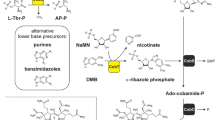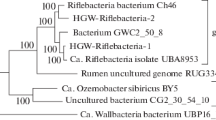Abstract
Acidiphilium cryptum JF-5, an acidophilic iron-respiring Alphaproteobacterium, has the ability to reduce chromate under aerobic and anaerobic conditions, making it an intriguing and useful model organism for the study of extremophilic bacteria in bioremediation applications. Genome sequence annotation suggested two potential mechanisms of Cr(VI) reduction, namely, a number of c-type cytochromes, and a predicted NADPH-dependent Cr(VI) reductase. In laboratory studies using pure cultures of JF-5, an NADPH-dependent chromate reductase activity was detected primarily in soluble protein fractions, and a periplasmic c-type cytochrome (ApcA) was also present, representing two potential means of Cr(VI) reduction. Upon further examination, it was determined that the NADPH-dependent activity was not specific for Cr(VI), and the predicted proteins were not detected in Cr(VI)-grown cultures. Proteomic data did show measureable amounts of ApcA in cells grown with Cr(VI). Purified ApcA is reducible by menadiol, and in turn can reduce Cr(VI), suggesting a means to obtain electrons from the respiratory chain and divert them to Cr(VI). Electrochemical measurements confirm that Cr reduction by ApcA is pH dependent, with low pH being favored. Homology modeling of ApcA and comparison to a known Cr(VI)-reducing c-type cytochrome structure revealed basic amino acids which could interact with chromate ion. From these studies, it can be concluded that A. cryptum has the physiologic and genomic capability to reduce Cr(VI) to the less toxic Cr(III). However, the expected chromate reductase mechanism may not be the primary means of Cr(VI) reduction in this organism.





Similar content being viewed by others
References
Assfalg M, Bertini I, Bruschi M, Michel C, Turano P (2002) The metal reductase activity of some multiheme cytochromes c: NMR structural characterization of the reduction of chromium(VI) to chromium(III) by cytochrome c(7). Proc Natl Acad Sci USA 99:9750–9754
Bansal R, Deobald LA, Crawford RL, Paszczynski AJ (2009) Proteomic detection of proteins involved in perchlorate and chlorate metabolism. Biodegradation 20:603–620
Barton LL, Goulhen F, Bruschi M, Woodards NA, Plunkett RM, Rietmeijer FJM (2007) The bacterial metallome: composition and stability with specific reference to the anaerobic bacterium Desulfovibrio desulfuricans. Biometals 20:291–302
Bordoli L, Kiefer F, Arnold K, Benkert P, Battey J, Schwede T (2009) Protein structure homology modeling using SWISS-MODEL workspace. Nat Protoc 4:1–13
Cervantes C, Campos-Garcia J, Devars S, Gutierrez-Corona F, Loza-Tavera H, Torres-Guzman JC, Moreno-Sanchez R (2001) Interactions of chromium with microorganisms and plants. FEMS Microbiol Rev 25:335–347
Chakraborty AR, Mishra RK (1992) Speciation and Determination of Chromium in Waters. Chem Speciation Bioavail 4:131–134
Chardin B, Giudici-Orticoni MT, De Luca G, Guigliarelli B, Bruschi M (2003) Hydrogenases in sulfate-reducing bacteria function as chromium reductase. Appl Microbiol Biotechnol 63:315–321
Cummings DE, Fendorf S, Singh N, Sani RK, Peyton BM, Magnuson TS (2007) Reduction of Cr(VI) under acidic conditions by the facultative Fe(III)-reducing bacterium Acidiphilium cryptum. Environ Sci Technol 41:146–152
Desai C, Jain K, Madamwar D (2008a) Evaluation of In vitro Cr(VI) reduction potential in cytosolic extracts of three indigenous Bacillus sp isolated from Cr(VI) polluted industrial landfill. Bioresour Technol 99:6059–6069
Desai C, Jain K, Madamwar D (2008b) Hexavalent chromate reductase activity in cytosolic fractions of Pseudomonas sp G1DM21 isolated from Cr(VI) contaminated industrial landfill. Process Biochem 43:713–721
Francis CA, Obraztsova AY, Tebo BM (2000) Dissimilatory metal reduction by the facultative anaerobe Pantoea agglomerans SP1. Appl Environ Microbiol 66:543–548
Francisco R, Alpoim MC, Morais PV (2002) Diversity of chromium-resistant and -reducing bacteria in a chromium-contaminated activated sludge. J Appl Microbiol 92:837–843
Ginder-Vogel M, Borch T, Mayes MA, Jardine PM, Fendorf S (2005) Chromate reduction and retention processes within arid subsurface environments. Environ Sci Technol 39:7833–7839
Gonzalez CF, Ackerley DF, Lynch SV, Matin A (2005) ChrR, a soluble quinone reductase of Pseudomonas putida that defends against H2O2. J Biol Chem 280:22590–22595
He YT, Bigham JM, Traina SJ (2005) Biotite dissolution and Cr(VI) reduction at elevated pH and ionic strength. Geochim Cosmochim Acta 69:3791–3800
Horton RN, Apel WA, Thompson VS, Sheridan PP (2006) Low temperature reduction of hexavalent chromium by a microbial enrichment consortium and a novel strain of Arthrobacter aurescens. BMC Microbiology 6:5–12
Humphrey W, Dalke A, Schulten K (1996) VMD-Visual Molecular Dynamics. J Molec Graphics 14:33–38
Kelley LA, Sternberg MJ (2009) Protein structure prediction on the Web: a case study using the Phyre server. Nat Protoc 4:363–371
Kieft TL, Fredrickson JK, Onstott TC, Gorby YA, Kostandarithes HM, Bailey TJ, Kennedy DW, Li SW, Plymale AE, Spadoni CM, Gray MS (1999) Dissimilatory reduction of Fe(III) and other electron acceptors by a Thermus isolate. Appl Environ Microbiol 65:1214–1221
Mazoch J, Tesarik R, Sedlacek V, Kucera I, Turanek J (2004) Isolation and biochemical characterization of two soluble iron(III) reductases from Paracoccus denitrificans. Eur J Biochem 271:553–562
Opperman DJ, van Heerden E (2008) A membrane-associated protein with Cr(VI)-reducing activity from Thermus scotoductus SA-01. FEMS Microbiol Lett 280:210–218
Opperman DJ, Piater LA, van Heerden E (2008) A novel chromate reductase from Thermus scotoductus SA-01 related to old yellow enzyme. J Bacteriol 190:3076–3082
Park CH, Keyhan M, Wielinga B, Fendorf S, Matin A (2000) Purification to homogeneity and characterization of a novel Pseudomonas putida chromate reductase. Appl Environ Microbiol 66:1788–1795
Schagger H, von Jagow G (1987) Tricine-sodium dodecyl sulfate-polyacrylamide gel electrophoresis for the separation of proteins in the range from 1 to 100 kDa. Anal Biochem 166:368–379
Sedlacek V, van Spanning RJM, Kucera I (2009) Characterization of the quinone reductase activity of the ferric reductase B protein from Paracoccus denitrificans. Arch Biochem Biophys 483:29–36
Tebo BM, Obraztsova AY (1998) Sulfate-reducing bacterium grows with Cr(VI), U(VI), Mn(IV), and Fe(III) as electron acceptors. FEMS Microbiol Lett 162:193–198
Viti C, Pace A, Giovannetti L (2003) Characterization of Cr(VI)-resistant bacteria isolated from chromium-contaminated soil by tannery activity. Curr Microbiol 46:1–5
Wolin EA, Wolin MJ, Wolfe RS (1963) Formation Of Methane By Bacterial Extracts. J Biol Chem 238:2882
Zayed AM, Terry N (2003) Chromium in the environment: factors affecting biological remediation. Plant Soil 249:139–156
Acknowledgments
The authors are grateful for support from the U.S. Department of Energy Environmental Remediation Science Program through Grant Number DE-FG-063626 (To TSM and DEC), and National Science Foundation Grant Number 0434023 (To TSM). We thank undergraduates Julienne Pharis and Andrew Fielding for laboratory assistance.
Author information
Authors and Affiliations
Corresponding author
Rights and permissions
About this article
Cite this article
Magnuson, T.S., Swenson, M.W., Paszczynski, A.J. et al. Proteogenomic and functional analysis of chromate reduction in Acidiphilium cryptum JF-5, an Fe(III)-respiring acidophile. Biometals 23, 1129–1138 (2010). https://doi.org/10.1007/s10534-010-9360-y
Received:
Accepted:
Published:
Issue Date:
DOI: https://doi.org/10.1007/s10534-010-9360-y




